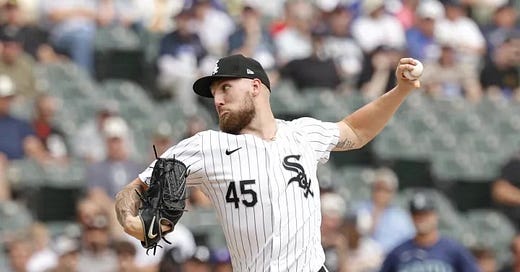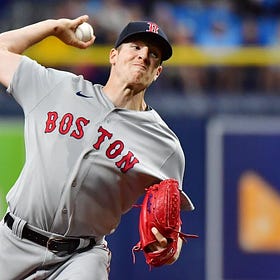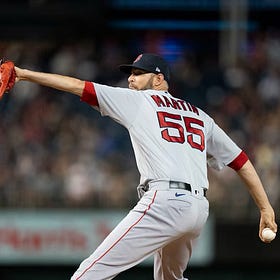The good, bad and ugly of a Red Sox-Crochet trade
Where there's smoke, there's often fire, but is trading for left-hander Garrett Crochet a smart move for the Boston Red Sox?
The Major League Baseball offseason kicked off with the annual General Manager Meetings in San Antonio.
While it’s natural to instantly gravitate to the impending sweepstakes centering around outfielder Juan Soto, there seems to be a lot of early smoke on the trade market of left-handed starting pitcher Garrett Crochet, of the Chicago White Sox.
Crochet missed all of 2022 to Tommy John Surgery, made just 13 appearances (12.2 innings) in 2023 and made his debut as an MLB starting pitcher on March 28, 2024 as Chicago’s Opening Day starter.
The 25-year-old made 32 starts in what was his first All-Star campaign, logging a 3.58 ERA and off-the-charts underlying metrics thanks in large part to a K-BB ratio north of six.
There’s little doubt the southpaw dons new threads in 2025, the main question is whose?
The Boston Red Sox kicked the tires, everyone’s favorite cliché, back in July but sort of gauging soft interest. After all, Crochet opened up that he wouldn’t pitch for an acquiring team in October with no extension, which sort of always felt impractical in the final two months.
Now, as reported by Sean McAdam of MassLive, the team is right in the thick of these sweepstakes. Jon Morosi of MLB Network shared similar sentiment, calling this potential trade agreement something of a Chris Sale 2.0.
Red Sox’ Craig Breslow on additions to the rotation: ‘I don’t think anything is off the table’
Red Sox chief baseball officer Craig Breslow met with the media in San Antonio for the GM Meetings to discuss extending the $21.05 million qualifying offer to Nick Pivetta.
With that in mind, as is always the case with making a trade of this magnitude, there are several reasons for and against it.
In Bostonian fashion, let’s start this “Good, Bad and Ugly” list with the ultra negative.
The Ugly
As mentioned, 2024 was the first year Crochet started in MLB. While the numbers are off the charts, he was on a drastic innings and pitch-count limit post All-Star Break.
Through July 14, he had a 3.02 ERA and 2.37 FIP to couple a K-BB ratio of 6.52 across 107.1 innings (20 starts). After, he made 12 more starts, logging just 38.2 innings and, while the peripherals remained elite, his ERA in that span was 5.12.
While Crochet and the White Sox made it pretty clear this was about body preservation and not blowing his arm out in his first season with a starter’s workload, the Red Sox dealt with the issue of unchartered waters for their starters last season.
All-Star Tanner Houck and fringe All-Star-worthy Kutter Crawford pitched essentially the entire second half with every out extending a new career-high for innings. Both endured significant struggles in the second-half, where even their good starts simply didn’t look the same.
This all without mentioning the potential trade package headed to Chicago should the two parties agree.
If Morosi’s “Sale 2.0” allusion refers to the cost, that likely equates to outfielder Wilyer Abreu and prospects Marcelo Mayer, Miguel Bleis and more headed to the White Sox.
That’s at least five years of this team’s future based on one year of success.
While you have to pay a premium to get someone of this caliber, Chris Sale was on another level when Boston got him before the 2017 season. He struggled by his standards in 2016, but was going on half a decade of dominance as a starter, logged over 220 innings in 2016 and had three years of control.
Crochet’s track record of dominance as a starter spans three months of a season he logged 146 innings following a season he returned from Tommy John Surgery. He also has two years of team control.
They just aren’t the same.
The Bad
If Crochet can’t handle the workload moving forward, you traded a potential All-Star and, at worst, a gold glove right fielder in addition to your shortstop of the future for someone who isn’t the ace of your staff.
Even if he replicates his 2024 season over, conservatively, 175 innings, that’s nowhere near enough volume out of your ace.
By trading someone like Mayer, you are decidedly keeping Trevor Story as the team’s shortstop for the remaining three years of his deal, with no real alleyway to trade him or move him back to second base.
Sure, Franklin Arias is a top 100 prospect on MLB Pipeline, but he’s in Salem — not exactly close to impacting winning in MLB. There’s also the very real possibility he just isn’t an MLB-caliber shortstop, whether defensively or otherwise.
Mikey Romero rebounded in 2024, going on a power surge, but he’s another lefty, which is something that seems to catch the ire of Red Sox fans and, to a degree, the front office.
Back to Crochet for a second, you’re still banking on a guy based on one season. While it’s as impressive a first season starting as you’ll find nowadays, there’s a chance he regresses and is fools gold.
After all, his dominance, which spanned three months, came on the literal worst team ever in the game’s least threatening division. By the time Detroit came out of nowhere, the southpaw was in his final 31.2 innings of the season — four of which came against the Tigers.
Not to mention his lone start at Fenway ending in four earned over two innings, including a two-run homer allowed to Tyler O’Neill.
Boston is a tricky market for people. We’ve seen players come from smaller market clubs and get overwhelmed by the lights and the ballpark and the media and the fans. It’s not for everyone.
Sure, you don’t *know* until you know, but for the presumed cost of acquisition, you should probably seek a greater track record than 20 starts of dominance.
Not to mention trading star talent within the league, which could become important for playoff seeding in a few years if Chicago’s rebuild goes well.
The Good
Scared you, didn’t I?
Yes, there’s obviously a ton of good that comes with acquiring a pitcher the caliber of Crochet.
For example, his value is substantially lower than it was last July simply based on the half-year less you have him under guaranteed control. Not to mention, considering the reason he stayed in Chicago last summer, you have multiple months to negotiate an extension so that this past summer’s mess isn’t repeated.
Given the perceived desire of Boston to spend, that bodes well for extending Crochet who, again, is just 25 years old. When they acquired Sale, he was already entering his age-28 season. So, while Sale’s track record was extensive, the phrase “ticking time bomb” was used a lot to describe the violent delivery and slender build of the former Red Sox ace.
This could just be the tip of the iceberg for Crochet. While there’s no way to know for sure, it’s hard to imagine someone that potent in striking guys out would just forget how to do it moving forward.
Additionally, it’s very hard to hit a baseball when it’s thrown 97-plus miles per hour.
In 2024, batters league-wide hit .220 with a .637 OPS and 24.6% whiff rate against 97 mph or faster. Crochet’s average fastball was 97.2 mph, which was in the 92nd percentile last season.
Opponents hit .198 with a 31.4% whiff rate against Crochet’s four-seamer last year. He also had the third-most strikeouts on pitches 97 mph or faster in 2024, trailing Tigers LHP Tarik Skubal and Cincinnati Reds RHP Hunter Greene.
Couple that with his 93rd percentile extension and you have a very uncomfortable at-bat every time up.
McAdam also reported he believes the aforementioned Abreu could headline that trade package, which at least in my estimation, all but eliminate a top-five organizational prospect from going to the White Sox. If that’s the case, and not the Morosi-proposed Sale-esque trade, this is a no-brainer.
He was in the Cy Young race through July for a reason. He has the arm talent to be perennially great, it’s just a matter of it coming to fruition.
Red Sox interested in bringing back veteran reliever in free agency
The Red Sox have two key members of their bullpen that are free agents this offseason in closer Kenley Jansen and reliever Chris Martin. There is no chance that Jansen will re-sign with Boston, but the club is expressing interest in bringing back Martin.







